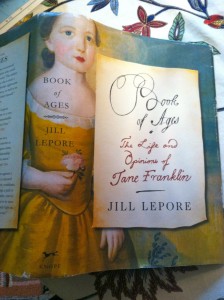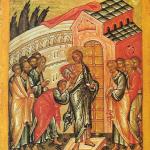 In Jill Lepore’s extraordinary biography of Ben Franklin’s sister Jane, Book of Ages, a short chapter near the end sketches the rise of the novel as a genre. Prior to the eighteenth century, “history” was the genre for telling the stories of lives, and they were always the stories of famous men. Then in the eighteenth century, novels began to be written, but at first they called themselves “histories”: Fielding’s History of Tom Jones, Sterne’s The Life and Opinions of Tristram Shandy are two that Lepore names. Richardson’s epistolary novel Pamela also purported to be real letters that Fielding had discovered.
In Jill Lepore’s extraordinary biography of Ben Franklin’s sister Jane, Book of Ages, a short chapter near the end sketches the rise of the novel as a genre. Prior to the eighteenth century, “history” was the genre for telling the stories of lives, and they were always the stories of famous men. Then in the eighteenth century, novels began to be written, but at first they called themselves “histories”: Fielding’s History of Tom Jones, Sterne’s The Life and Opinions of Tristram Shandy are two that Lepore names. Richardson’s epistolary novel Pamela also purported to be real letters that Fielding had discovered.
Soon, though, novelists dropped pretense of writing history, because they were convinced that their new genre was truer than history. It was a new kind of biography—of ordinary people—and its truth was founded not in documentary evidence but in human nature.
I was reminded of this while recently reading Kent Haruf’s novels Plainsong, Eventide, and Benediction, all set in his fictional town of Holt, Colorado, on the high dusty plains east of Denver. The small events of very ordinary lives are Haruf’s subject. In a spare, understated style, Haruf creates characters who surprise themselves with a generous gesture, who suffer from depression or loss or the meanness of others, who settle into habits of sadness or of gratitude.
Reading along, I would often stop and think: “this is life as it really is.”
Lepore’s terms helped me understand why I keep reading fiction: because fiction connects me with the truth of other lives. And so with the truth of my own.
“How we spend our days is, of course, how we spend our lives,” Annie Dillard says in The Writing Life. It’s almost impossible to stand back from our own days and take account of how we’re spending them. But fiction traces in minute detail the spending of days—and so the spending of lives.
Fiction also traces the interconnections among lives. In each of Haruf’s novels, we begin with the tracing of days of separate characters. Then, unexpectedly, one character will enter another’s life. It might be in a small way, like an elderly woman chatting warmly with two young boys whose mother has left them. Or it might be in a huge way, like two aging brothers hesitantly opening their home to a pregnant high school girl, who eventually enriches their lives in ways they couldn’t have imagined.
My life has so many interconnections with others that I couldn’t begin to trace them. But in fiction I can see the reality of how lives inevitably yet surprisingly entwine.
One of my favorite Anne Tyler novels, Saint Maybe, ends with an oh-wow scene that dramatizes exactly this. The novel has followed the protagonist Ian’s ways of living out his sense of responsibility for his brother Danny’s death, soon after Danny married Lucy.
In this final scene, Ian is carrying his newborn daughter downstairs to meet family and friends who are gathered there.
He was halfway down the stairs when he felt a kind of echo effect—a memory just beyond his reach. He paused, and Danny stepped forward to present his firstborn. “Here she is!” he said. But then the moment slid sideways like a phonograph needle skipping a groove, and all at once it was Lucy he was presenting. “I’d like you to meet the woman who’s changed my life,” he said. His face was very solemn but Lucy was smiling. “Your what?”she seemed to be saying. “Your, what was that? Oh, your LIFE.” And she tipped her head and smiled. After all, she might have said, this was an ordinary occurrence. People changed other people’s lives every day of the year. There was no call to make such a fuss about it.
Yes, people do change each other’s lives every day of the year. But it takes fiction for us to see the fullness of this truth.
A few years ago, in The New York Review of Books, Colm Toibin reviewed two new books by the South African writer Nadine Gordimer. One was a collection of her essays and speeches on the politics of her country especially under apartheid; the other was a collection of her short stories. Comparing the two books (and considering as well Gordimer’s major novels), Toibin observes that in her essays and speeches “she made rhetoric of considerable and persuasive force, filled with anger and fire… But she made her fiction out of a set of more complex, mysterious, and tender arguments.”
“In her nonfiction,” Toibin goes on, “Gordimer knows who the heroes and villains are; in her best stories, she allows her characters to be puzzled, to be caught between forces. She allows her best creations a full life that can be poisoned or damaged by apartheid but not fully foretold or controlled by the system.”
What I hear Toibin saying is that Gordimer’s fiction is truer to life than her nonfiction. Surely our lives are mysterious and unpredictable; outside forces influence but do not predetermine them.
When I want to learn facts, I read history or essays. When I want to absorb truth, I reach for fiction.
Peggy Rosenthal is director of Poetry Retreats and writes widely on poetry as a spiritual resource. Her books include Praying through Poetry: Hope for Violent Times(Franciscan Media), and The Poets’ Jesus (Oxford). SeeAmazon for full list. She also teaches an online course, “Poetry as a Spiritual Practice,” through Image’s Glen Online program.















